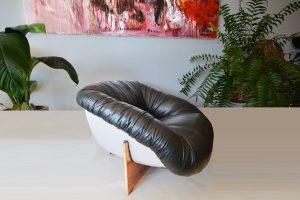(NOTE- any white spots in the photos are a problem with my camera- not the chairs! These chairs SOLD for $1995 the pair back in 2015 from Melbourne. The buyer of these re-sold the pair later through iNVISeDGE in 2018 and they sold for $2750, only 3 years on (he made a profit on these even after my commission fees were deducted). These days in 2020 I’d price the exact same pair of chairs at around $3400 the pair. They’re really RARE!)
Provenance and Background Info
(Description written in 2015.)
A pair of F598 armchairs manufactured by Artifort and designed by Pierre Paulin in 1973. The M-Chair or Groovy chair was ground-breaking design at the time and as such is held in the National Gallery of Victoria, Melbourne. The suspended shape was a first but what I like most is the sensational comfort. Form melds with function in these chairs. They not only look out-of-this-world but they’re great to sit in- the angles, proportions and padding are all brilliant. You feel well supported in the F598 and the level of cushioning and “give” in the seat section is spot-on.
This pair of chairs came out of an upmarket office foyer in Sydney city (I got these sent to Melbourne because our Sydney depot is temporarily closed). The upholstery is hopsack- the same upholstery used in Eames chairs I’ve had in the past (the Eames aluminium-group chairs manufactured by Herman Miller). Hopsack is a natural fibre- it’s resilient and the weave is stunning. This is the original covering. I was told the chairs were purchased new in 1981 and used in a commercial foyer up until 4 years ago. The condition of these chairs is testament to the quality of the fabric. In my eyes it looks as though the fabric is going to stand up to another 40 years at least- it shows very little wear (if any).
In the 17 years I’ve been in this business, this is the second Artifort Pierre Paulin F598 chair I’ve stocked. (The others sold immediately for $2000 the pair and the buyer paid an extra $300 in freight- those chairs attracted a mountain of interest.) I rate this pair much higher. The fabric on these is better. Black is also timeless, practical and will adapt to most interiors. This is a rare opportunity to get a pair of these in a fabric colour you’d choose yourself.
F598’s are rarely seen in Australia (most have been bought across from Europe by architects and interior designers, usually for commercial waiting areas). Very few (if any) were sold in Australian retail stores back in the day. Vintage pairs of F598 chairs show up occasionally in high-end auction centres in Sydney and Melbourne- otherwise you won’t see them. I can only find a handful of these chairs for sale worldwide at the time of writing this description. They’re priced at around AU$5000 THE PAIR (IN AMERICA). Some F598 chairs have a decal label on the floor-slide but most don’t. All Artifort F598’s have a small “A” imprinted on the front end of each floor slide and this pair is no exception as shown in one of the photos.
I’ve seen a photo of the inner-construction of a F598 chair- a chair had the covers ripped off ready for re-upholstery. The inner-frame of these chairs is steel with steel springs in the seating area making them very strong and durable (and a lifetime investment).
Above the financial advantage of investing in vintage furniture there’s the satisfaction of knowing there are very few better ways to reduce landfill. Investing in items that were built to last and designed with respect to our earth’s resources is our only way out of this mess.
Ref- around 1910





















